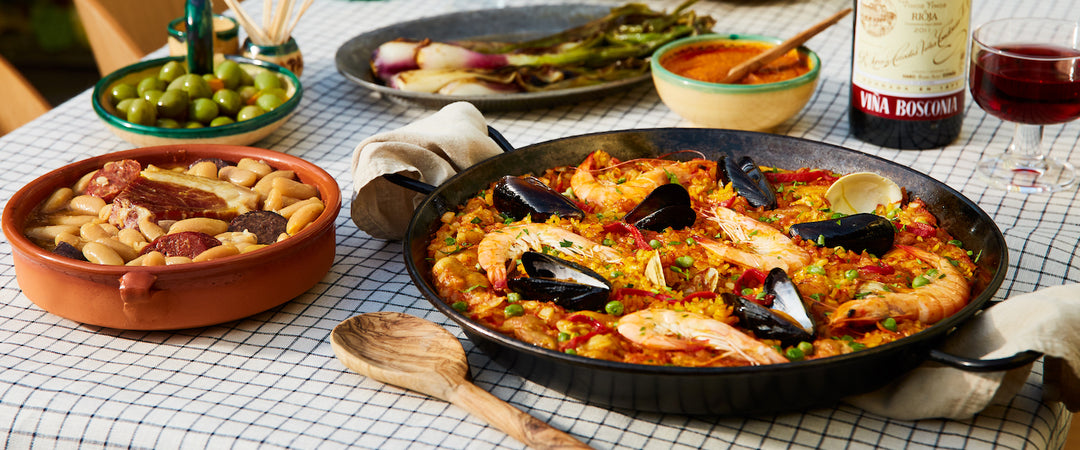February 2025 Blanco y Tinto Club
 
|
Bodegas Ordonez 2022
|
It’s no secret that we are unabashed fans of Jorge Ordoñez’s selections. From Bodegas Muga to La Caña to Ramirez de la Piscina, you’ve seen this importers' wines on our walls time and time again. Whether you’ve consumed his wines continuously or not, if you’ve shopped our wine section for any decent amount of time, it's likely you’ve already taken part in Jorge Ordoñez’s voracious following. If we’re being honest, looking for his name on the reverse side of the bottle is a great way to do ‘backlabel shopping’, but more on that in another blog post. We’ll talk about the Garnacha we’ve selected in a moment, but first we’d like to express that we share a philosophical kinship to Jorge Ordoñez.

When the man himself arrived in the United States in 1987, he discovered a significant lack of quality Spanish wine available. This was due to a couple reasons. This first was that after Prohibition tore up much of the country’s Spanish and Italian grape vines, international French varieties were planted in their stead. This made domestic consumers more familiar with the varieties of Cabernet Sauvignon, Pinot Noir and Chardonnay rather than the Iberian and Italian grapes that were here long before. Look in any grocery store and you’ll see this trend continues to this day. The second reason for the poor presence and reputation of Spanish wine was due to inadequate shipping conditions. Spain is hot, and going from unconditioned warehouse, to truck-bed, to sitting in the sun on the Atlantic is a perilous and quality-infringing journey for a pallet of wine. Similar to our own mission statement, Jorge Ordoñez thus set out to bring true, unadulterated tastes of Spain to the American people. He began by advocating for proper handing of imported wine, demanding they be refrigerated at all steps of the journey. As Americans began to take notice, Ordoñez expanded into the production side of the wine trade, opening bodegas and working with winemakers in order to highlight indigenous varieties and terroirs all across Spain. To this day, his work serves as a cornerstone of the domestic Spanish wine market.

It was no surprise when we came across a Garnacha from his hometown, produced under a winery of his own namesake, we were instantly enamored. Deep in the south of Spain, high in the mountain ranges of Sierras de Málaga, Ordoñez grafted Garnacha from his holdings in Calatayud. The vines in Malaga planted with these cuttings have been maturing on their steep hillsides since 2010. The slopes here are steep, some angles teetering up to 60°. Everything here has to be hand farmed, no wheeled machinery is safe on these grades. The vineyards are dry farmed, organic, and each vine is goblet-trained or shaped into a cup to protect the grapes from the unwavering sun.

In respect for the character of the grapes, only very gentle winemaking techniques were used. After a quick maceration in open-open fermenters, the juice is then transferred to demi-muid to undergo full malolactic conversion for softness. The wine then takes a quick nap for 6 months in old French oak barrels before bottling. While the final ABV reads about 14.5%, this retains a surprising amount of elegance. Ethereal red and black berries intermingle with dusty earth and subtle pepperiness. Enjoy with grilled lamb or steaks, or feel free to experiment with richer Spanish seafood dishes, such as bacalao a la vizcaina or zarzuela de mariscos.
PS: as this writeup was (wonderfully) done by one of our wine staff, I am adding only a small footnote. I was privileged to visit the vineyards from where these wines hail in Malaga. It is THE most unusual setting. Steep, 45º mountainside vineyards in dry mountains high above the mediterranean. SO steep in fact that only locals and donkeys harvest here because outside helpers only trip, fall and hurt themselves on these slopes.


And, to leave you longing, here is a snapshot of the moment when I decided to bring us all 10 cases of this amazing wine:

 
|
Villota 2022
|
Picture yourself having been magically transported to a vineyard in Spain’s Rioja region. The vineyard sits in a river bend of the Ebro river and is full of gorgeous vines loaded with plump black grape clusters and adorned with fall leaves turning red. It’s the golden hour, and the sun’s rays are shining through the branches of a majestic old oak tree. Under the tree is a long table set with white linen tablecloths and wine glasses. The wine growers speak, and alongside gorgeous nibbles of local fare, you get to try an array of white and red wines, whilst sitting amidst the vines that produced them. A dream, you ask yourself? Well, as it turns out, the scene pictured above was one I got to experience in September of last year. As a wine lover, it was certainly hard NOT to like any wine poured in such a setting. As a wine professional, I was able to determine objectively that the talent of the growers and winemakers at Villota is the ability to put the magic of that setting into the bottle.

Let’s dive in.
The tree in the scene above is part of the vineyards of the Finca San Rafael owned by the Pérez-Villota family. These vineyards span across a set of down-sloping terraces in a bend of the river Ebro, about 15 minutes north of the town of Logroño in the Rioja Alavesa subregion of the Rioja DOC.


Soils here are iron-rich clay with a high proportion of limestone. Owing to the fact that this section of Rioja was once under the ancient giant version of today’s Ebro river, the soil is littered with all different sizes of round riverstones.

Planted in the vineyard are Graciano, Mazuelo, Tempranillo, Viura, Tempranillo Blanco, and Garnacha Blanca. The vines are 60 or more years old, goblet trained as is customary in Spain, and dry-farmed. The Pérez-Villota family cares deeply about their land and vines, and refrain from the use of systemic herbicides, fungicides, pesticides, or fertilizers. We were lucky enough to be there while fruit were on the vines, and the quality of the grape clusters and the taste of the fruit were outstanding.
The Pérez-Villota family is quite famous. For decades, they grew grapes as partners of CVNE’s famous Contino label. Co-founded in 1973 by the Rioja wine giant CVNE and the Pérez-Villota family, Contino was a new venture focused on single vineyard “chateau-style” wines with wines from each plot of grapes vinified separately. For decades, Contino has been lauded for its quality. Wine scores as we know them today do not date back to 1973, so there are no scores on a 100 point scale for early Contino vintages, but over more recent years, Contino has consistently scored in the mid to high 90 point range. In 2013, unafraid to make great into even greater, the Pérez-Villota family decided to part ways with CVNE, starting their own Villota label. Their Selvanevada line are lovely everyday wines in a portfolio that has many wines that easily reach the quality level of Contino, proving that the Pérez-Villota family has been able to continue doing the right things to put their terroir in bottles.
This wine is a blend of Viura (91%), Tempranillo Blanco (6%), Garnacha Blanca (3%). While Viura is usually the mainstay for Rioja whites, the Tempranillo Blanco and Garnacha Blanca add a twist to this blend. It is simply a joyful wine! It pours a very light yellow into the glass. On the nose, it presents and intriguing mix of rhubarb, apple, riverstone, and the faintest hint of smoke. On the palate, it is a crisp and fresh treat, almost spicy and herbaceous on the tip of the tongue, then a blend of warm pear, melon and some touches of wood. The wine does not see malolactic fermentation, keeping it crisp and fresh. Part of the wine see aging on the lees, which gives it its broader palate. I often joke of "if X and Y grape had a baby". To me, the joke for this wine is if Albariño and unoaked Chardonnay had a baby, Villota's Selanavada Blanco would be its name. This wine is a great sipper with anything from a chilean seabass filet seared and baked, a seafood stew, a white sauce pasta, or if kept until a warmer spring day, for the first outside garden party with a cheese board (with some black olive tapenade) to summon the spirit of the table in the vineyard above. I won't be able to wait that long, but maybe you will.
On a commercial footnote, we are the only California retailer to carry this vintage of this wine and we have committed to a large buy of this wine. This means there is plenty for you if you love it. It also means we appreciate your sharing this with friends and family so we can sell through our allocation.



